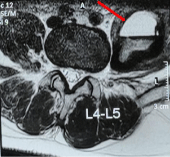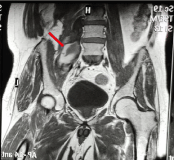
Case Report
Ann Surg Perioper Care. 2021; 6(1): 1044.
Iliopsoas Hematoma Mimicking Femoral Neuropathy
Asati S*, Kundnani VG, Sagane SS, Jain S and Raut S
Mumbai Institute of Spine Surgery, Bombay Hospital and Medical Research Centre, India
*Corresponding author: Sanjeev Asati, Mumbai Institute of Spine Surgery, Room no 128, First Floor, M.R.C. Wing Bombay Hospital and Medical Research Centre, Marine Lines, Mumbai, India
Received: February 02, 2021; Accepted: February 12, 2021; Published: February 19, 2021
Abstract
Iliopsoas hematoma should be considered in the differential diagnosis of femoral neuropathy in patients who are on chronic warfarin therapy. It usually presents with groin or thigh pain, and in rare instances, large bleeding may cause hypovolaemic shock. Conservative management has a good clinical and neurological outcome in such cases.
Keywords: Iliopsoas hematoma; Femoral neuropathy; Warfarin therapy; Thigh pain; Bleeding
Introduction
Iliopsoas hematoma could be a rare and serious complication of bleeding disorders, most frequently happen in patients with haemophilia but can be seen in patients on anticoagulation therapy for other disorders [1]. It should be considered in the differential diagnosis of femoral neuropathy in patients who are on thromboprophylaxis. Here we present a case of spontaneous iliopsoas hematoma in a patient on chronic warfarin therapy.
Case Report
A 58 years old male patient presented with acute onset left thigh pain with inability to walk, without any history of fall or trauma. He was unable to extend his left hip and had radicular pain from left groin to left knee associated with paraesthesia. The patient had a history of double valve replacement in 2001 for Rheumatic heart disease and Percutaneous Transfemoral Coronary Angioplasty (PTCA) in 2016. On admission his blood investigations were: Hb 9 g/dl, haematocrit 27%, platelets 3.25 lakhs and INR (International normalized ratio) was 9.8. He was on oral warfarin for thromboprophylaxis. Clinical examination showed pain on passive extension of left hip (psoas sign positive). Neurological examination showed less power (Medical research council grade 3/5) in left L2 and L3 myotomes compared to right side and hypoesthesia in left thigh anterior aspect. In view of the clinical and neurological findings, MRI of lumbosacral spine was done which showed a large hematoma in left psoas muscle of 10.2×4.2×4.4 cm. Keeping in mind the increased risk of bleeding complications and mortality in such patients, conservative treatment in the form of Vitamin K and 4 Fresh Frozen Plasma (FFP) was given immediately. Patient was advised bed rest and Oral warfarin was stopped for two days until normalisation of INR. Follow-up examination at two weeks showed good improvement clinically and neurologically and at four weeks there was a complete neurological recovery.
Discussion
Bleeding complications associated with the use of warfarin includes gastrointestinal, intracranial, rectus sheath and retroperitoneal haematomas. The reported incidence of bleeding complications per year in patients taking anticoagulants is 1-7% [2]. Since the muscle is deep seated, iliopsoas hematomas secondary to trauma are an uncommon entity. Howbeit they are well described in the literature and their incidence remains uncommon. Tallroth first reported iliopsoas haemorrhage in 1939 in a patient with haemophilia. Subsequently, Debolt in 1966, reported two cases of femoral neuropathy due to heparin induced iliopsoas hematomas [1]. Typical presentation is with lower abdominal, groin or thigh pain, and in rare instances large bleeding may cause hypovolaemic shock. Ureteric compression may cause hydronephrosis and if the compression is bilateral it can cause acute renal failure. Compressive femoral neuropathy with an acute lower limb sensory numbness, paraesthesia or muscle weakness may occur in cases where the haematoma in the iliacus or psoas muscle compresses the femoral nerve as it passes through these muscles [3]. It is particularly susceptible to compression within the body of the psoas muscle, at the iliopsoas groove and at the inguinal ligament. On physical examination, the limb is kept flexion on the involved side and pain is elicited on passive extension (psoas sign) as the iliopsoas muscle is stretched (Figure 1&2).

Figure 1: Axial section (T2 weighted image, hyperintense) at L4-L5 level
showing a well-defined left iliopsoas hematoma.

Figure 2: Coronal section (T2 weighted image, hyperintense) lumbar spine
showing left iliopsoas hematoma.
Ultrasonography is the first radiological investigation to diagnose iliopsoas haematomas but it has a lower sensitivity, and it is technically difficult due to the deep location of the muscle and obscuration by the intestine. Magnetic resonance imaging is the investigation of choice due to its high sensitivity and specificity.
Management of spontaneous iliopsoas haematoma varies between observation and surgical intervention [1-5]. It depends upon the time of diagnosis, hemodynamic status of the patient, size of the hematoma, comorbidities and associated neurological impairment. For smaller hematoma conservative management in the form of bed rest, immediate discontinuation and, if necessary, the antagonization of the anticoagulant therapy as well as the application of strong analgesics followed by gradual mobilization is employed. Wells and Templeton [4] estimated that 17 of 25 (68%) patients reported in the literature had a good outcome without surgery. They also expressed serious doubt whether operative intervention would have improved the outcome significantly. On the other hand, butterfield et al., in their study observed that only 2 out of 10 conservatively treated patients recovered fully. They have seen a high percentage of residual disability with prolonged recovery time in conservatively treated patients [5].
We managed our patient conservatively by correcting the coagulation dysfunction, giving fresh frozen plasma and vitamin K. We also monitored the INR, haemoglobin level, clinical and neurological symptoms on daily basis. Patient recovered fully at four weeks. Though enough literature is already available on spontaneous iliopsoas hematoma, it is still a rare entity. This case exemplifies an uncommon cause of a common complaint and also is a timely reminder that uncommon causes must be considered in any patient on warfarin Therapy. Through this case we are highlighting the importance of keeping spontaneous iliopsoas hematoma as a differential diagnosis for lower limb radiculopathy and weakness in patients who are on thromboprophylaxis. Proper history taking, clinical examination and consideration of relevant differential diagnoses are important in such cases.
Conclusion
Spontaneous iliopsoas haematoma in patients who are on warfarin therapy is uncommon and has been described in literature. It should be always kept in mind as a differential diagnosis of femoral neuropathy in such patients. Conservative line of management provides good result in terms of clinical and neurological recovery.
References
- Basheer A, Jain R, Anton T, Rock J. Bilateral iliopsoas hematoma: case report and literature review. Surgical neurology international. 2013; 4: 121.
- Beyth RJ. Management of haemorrhagic complications associated with oral anticoagulant treatment. Expert Opin Drug Saf. 2002; 1: 129-136.
- Ong H S. Compressive femoral neuropathy: rare complication of anticoagulation. Singapore Med J. 2007; 48: e94-e95.
- Wells J, Templeton J. Femoral neuropathy associated with anticoagulant therapy. Clin Orthop. 1977; 124: 155-160.
- Butterfield WC, Neviaser RJ, Roberts MP. Femoral neuropathy and anticoagulants. Ann Surg. 1972; 176: 58-61.